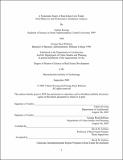| dc.contributor.advisor | David M. Geltner. | en_US |
| dc.contributor.author | Kwong, Valerie, S.M. Massachusetts Institute of Technology | en_US |
| dc.contributor.author | Robison, George Ryan | en_US |
| dc.contributor.other | Massachusetts Institute of Technology. Center for Real Estate. | en_US |
| dc.date.accessioned | 2010-10-22T20:48:25Z | |
| dc.date.available | 2010-10-22T20:48:25Z | |
| dc.date.copyright | 2005 | en_US |
| dc.date.issued | 2005 | en_US |
| dc.identifier.uri | http://hdl.handle.net/1721.1/59518 | |
| dc.description | Thesis (S.M. in Real Estate Development)--Massachusetts Institute of Technology, Dept. of Architecture, Center for Real Estate, 2005 [first author]; and, (S.M. in Real Estate Development)--Massachusetts Institute of Technology, Dept. of Urban Studies and Planning, Center for Real Estate, 2005 [second author]. | en_US |
| dc.description | This electronic version was submitted by the student author. The certified thesis is available in the Institute Archives and Special Collections. | en_US |
| dc.description | Includes bibliographical references (leaves 57-58). | en_US |
| dc.description.abstract | The returns and portfolio characteristics of core funds were tested for evidence of herd behavior and performance relative to the NCREIF Property Index (NPI), using a proprietary database that included data from 1985 to 2004. Tests performed include descriptive statistics, regression analysis, and attribution analysis. Results indicate that herd behavior tends to be somewhat correlated with the NPI return. Through our disaggregate (fund specific) analysis, we find that herd behavior, where managers base investment decisions on the collective actions of the market rather than their individual beliefs, may be present in the core fund industry. Regression analysis suggests that herding appears to be positively correlated with fund size and negatively correlated to leverage, fees, and persistence from the one-year lag of the deviation from the mean. Performance analysis results indicate that although fund leverage has increased significantly over time, the use of debt has produced little or no additional return to investors. We found that across funds, net returns to real estate fall short of the NPI, and that across time, there is a negative correlation between the performance of the index and fund performance relative to the index. | en_US |
| dc.description.abstract | (cont.) Attribution analysis revealed that property selection returns have produced the greatest amount of return deviation from the NPI over time, and that selection and strategy returns are negatively correlated. Regression analysis suggests there is persistence in fund performance in the short term, that a fund's fee is positively correlated with gross returns, although that does not necessarily translate into higher returns to the investor, and that larger funds are negatively correlated with performance. | en_US |
| dc.description.statementofresponsibility | by Valerie Kwong and George Ryan Robison. | en_US |
| dc.format.extent | 58 leaves | en_US |
| dc.language.iso | eng | en_US |
| dc.publisher | Massachusetts Institute of Technology | en_US |
| dc.rights | M.I.T. theses are protected by
copyright. They may be viewed from this source for any purpose, but
reproduction or distribution in any format is prohibited without written
permission. See provided URL for inquiries about permission. | en_US |
| dc.rights.uri | http://dspace.mit.edu/handle/1721.1/7582 | en_US |
| dc.subject | Architecture. | en_US |
| dc.subject | Urban Studies and Planning. | en_US |
| dc.subject | Center for Real Estate. | en_US |
| dc.title | A systematic study of real estate core funds : herd behavior and performance attribution analysis | en_US |
| dc.type | Thesis | en_US |
| dc.description.degree | S.M.in Real Estate Development | en_US |
| dc.contributor.department | Massachusetts Institute of Technology. Center for Real Estate | en_US |
| dc.contributor.department | Massachusetts Institute of Technology. Department of Architecture | |
| dc.contributor.department | Massachusetts Institute of Technology. Department of Urban Studies and Planning | |
| dc.identifier.oclc | 66144065 | en_US |
